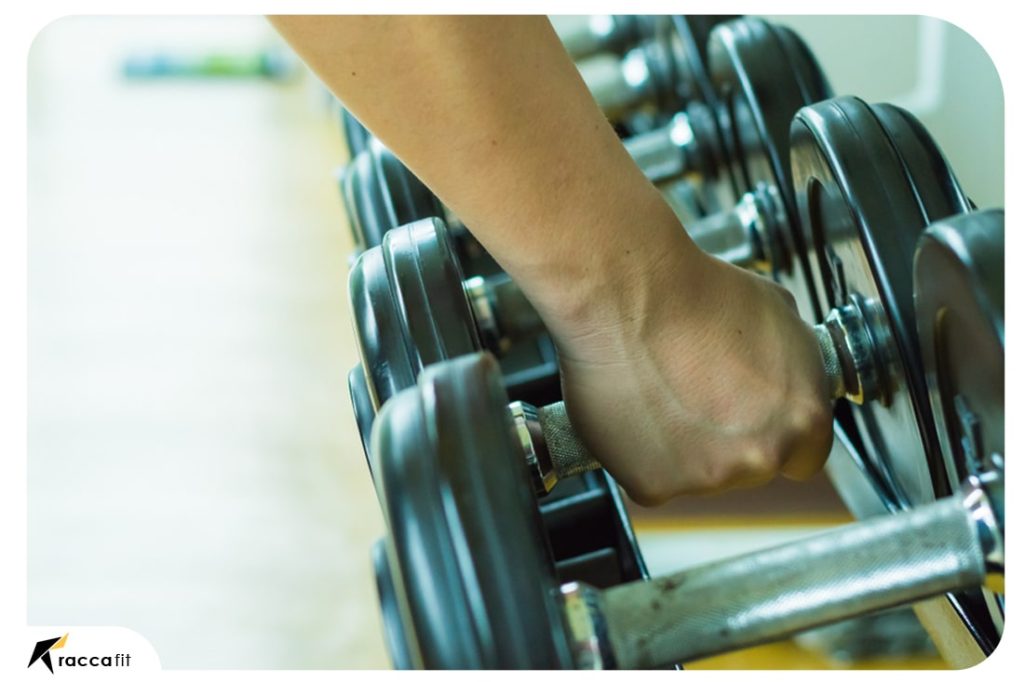Welcome to the world of high-intensity workouts. Today, we’re taking a deep dive into the devil press exercise, a powerful and challenging full-body workout that has been hailed as the ultimate test of fitness. The devil press isn’t for the faint-hearted. It’s a beast of an exercise that demands everything you’ve got – strength, agility, and a relentless determination. The potential for significant benefits awaits those who are up for the challenge. So, let’s get to it.
What is the Devil Press Exercise?
The devil press exercise is a compound movement, meaning it combines multiple exercises into one. Think of it as a burpee and a dumbbell snatch rolled into one intense, calorie-burning workout. When adopting the devil press, each part of your physique will be engaged: arms, legs, core, heart and even determination. No shortcuts can be taken in this exercise routine. This exercise requires commitment and grit, and in return, it delivers impressive results.
The Benefits of the Devil Press Exercise
The devil press exercise is more than just a test of your physical limits. It’s a test of your mental toughness too. But the struggle is worth it, and here’s why:
Cardiovascular Endurance
Cardiovascular fitness is at the core of overall health, and the devil press is a fantastic way to improve it. Due to its vigorous nature, this activity challenges your cardiovascular system to the maximum. Your heart rate will climb rapidly, forcing your body to consume more oxygen and enhancing your cardiovascular endurance. And as your cardiovascular fitness improves, so will your stamina, allowing you to push yourself further in your workouts and daily activities.
Full Body Strength
The devil press is a full-body workout in the truest sense. Every single rep forces your entire body to work in unison. The burpee portion targets your chest, shoulders, and legs, while the dumbbell snatch works your back, arms, and core. This makes the devil press an excellent exercise for overall strength development.
Functional Training
The beauty of the devil press lies in its real-world applicability. It’s a functional exercise, which means it trains your muscles to work together, preparing them for daily tasks and activities. Whether it’s picking up a heavy box, playing a sport, or even just getting up from the floor, functional training can make these movements easier and more efficient.

How to Properly Execute a Devil Press Exercise
Having examined the definition and merits of the devil press, it is now essential to explore the intricacies of performing this maneuver accurately.
Required Equipment
While some may prefer to incorporate elaborate equipment into their fitness regime others may appreciate the simplicity of the devil press exercise which only necessitates a basic set of dumbbells. Choose a weight that challenges you, but doesn’t compromise your form. As your strength improves, feel free to increase the weight.
Positioning and Setup
Start by standing upright with the dumbbells placed at your feet, your feet shoulder-width apart. This starting position should feel comfortable and balanced.
Movement Steps
- Squat down: Bend at the knees and hips to squat down and place your hands on the dumbbells. Your back should be straight and your chest lifted.
- Plank position: Kick your feet back and enter a high plank position. To avoid strain or injury. Correctly place your hands beneath your shoulders and maintain a straight alignment from head to toe.
- Push-up: Maintain proper technique during this exercise by bringing your body closer to the ground in a controlled manner while keeping your elbows snug against your sides. Press back up to return to the plank position.
- Jump forward: Jump your feet forward to your hands. Aim to land softly and quietly, preparing your body for the next part of the movement.
- Dumbbell swing: In a fluid motion, swing the dumbbells from the floor to above your head. This part of the movement is similar to a kettlebell swing or a dumbbell snatch.
- Repeat: Lower the dumbbells back to the starting position and prepare for your next rep. Remember, the devil press is a fluid exercise; each movement should flow into the next.
Common Mistakes and How to Avoid Them
With an exercise as complex as the devil press, there’s a lot that can go wrong. Some common mistakes include:
- Rounding your back: This usually happens during the push-up or dumbbell swing. To avoid this, engage your core and keep your back straight throughout the exercise.
- Swinging the dumbbells without engaging your core: This can lead to back pain or injury. To avoid this, make sure your core is engaged during the dumbbell swing.
- Neglecting the push-up: The push-up is an integral part of the devil press. Don’t skip it just because it’s hard!

Variations of the Devil Press Exercise
Even the most passionate devil press fans need a change every now and then. If you’re one of them, here are some variations you can try:
Dumbbell Devil Press
This is the classic version of the devil press. It’s straightforward, but don’t underestimate its difficulty!
Kettlebell Devil Press
If you have kettlebells at your disposal, why not use them? The kettlebell devil press adds a different dimension to the exercise, challenging your grip and coordination.
Barbell Devil Press
Got a barbell? Give this variant a shot. The barbell devil press is even more challenging, as it requires you to control the path of the barbell, making it a real test of your stability and control.
Incorporating Devil Press into Your Routine
For those considering including the devil press in their exercise regimen its understandable to wonder how best to go about doing so. The good news is that this dynamic exercise can be incorporated in a multitude of workout formats with ease.
- High-intensity interval training (HIIT): Add the devil press to your HIIT routines. It’s a high-intensity move that’ll skyrocket your heart rate, making it perfect for this kind of training.
- Circuit training: Include the devil press in your circuits. It’ll keep the intensity high and work multiple muscle groups at once.
- Strength training: Use the devil press as a compound exercise in your strength training sessions. Just remember to use heavier weights for a lower number of reps.
Precautions and Contraindications
Like all exercises, the devil press comes with certain risks, especially for those with pre-existing health conditions or injuries. Before you jump in, consider the following:
- Consult a healthcare provider: Your physical health is of utmost importance, which is why seeking guidance from a qualified healthcare professional before starting any new exercises should be a top priority. By discussing any potential concerns or issues with an expert in the field you can ensure that you are engaging in physical activity safely and effectively. Remember – prevention is key!
- Start slow: If you’re new to the devil press or high-intensity workouts in general, start slow. Begin with lighter weights and fewer reps and gradually increase as your fitness improves.
- Focus on form: Always prioritize form over speed or the number of reps. Poor form can lead to injuries.

Progressions and Regressions for the Devil Press Exercise
Progressing or regressing an exercise like the devil press can seem intimidating due to its complexity, but with the right approach, you can adapt the workout to your current fitness level and continue to challenge your body as you improve.
Using Resistance Bands
One progression strategy for the devil press involves the use of resistance bands. By securing the bands around your dumbbells, you can add an extra layer of resistance to the upward swing of the movement. This increases the demand on your muscles, especially the deltoids and trapezius, and challenges your body in a new way.
You can further adjust the resistance level by using bands of different strengths. If you’re seeking ways to push yourself and progress in fitness goals, choosing a high-resistance band might be worth considering. As explained earlier, utilizing such devices will require added energy from muscle groups each time one performs exercises using them. With gradual adjustment over time-plus proper nutrition-you could achieve great results on this front!
Adding a Weighted Vest
Another progression is to add a weighted vest to the exercise. The added weight increases the overall demand on your body during both the push-up and the burpee components of the devil press. The extra weight will particularly challenge your core, lower body, and upper body muscles, pushing you to build strength and endurance over time.
To safely add a weighted vest to your devil press workout, start with a lighter vest and gradually increase the weight as your fitness improves. Also, ensure the vest fits snugly and doesn’t restrict your movement.
Modifying the Push-Up
If you’re finding the push-up component of the devil press challenging, there are ways to regress the exercise until you’ve built up enough strength. One modification is to perform knee push-ups, where you rest your knees on the ground. This reduces the amount of bodyweight you’re lifting, making the push-up easier.
Another modification is the incline push-up, where you place your hands on an elevated surface like a bench. This reduces the angle at which you’re pushing, reducing the intensity of the exercise.

The Role of Nutrition in Enhancing Performance in Devil Press
In high-intensity workouts like the devil press, nutrition plays a crucial role in fueling your body and promoting recovery. Here’s what to consider:
Pre-Workout Nutrition
Before a devil press workout, your body needs the right nutrients to perform at its best. Aim for a balanced meal or snack about 1-2 hours before your workout, ensuring you include carbohydrates for energy and protein for muscle support.
Complex carbohydrates like whole grains or fruits provide a slow and sustained release of energy, preventing energy crashes during your workout. Pairing your carbs with protein, like Greek yogurt or a protein shake, helps prepare your muscles for the workload ahead.
Post-Workout Nutrition
After a high-intensity workout like the devil press, your muscles will be in a state of breakdown, and your energy stores will be depleted. Consuming a post-workout meal or snack rich in protein and carbohydrates within 45 minutes of your workout can kickstart the recovery process.
The benefits of optimal nutrition are essential when striving for physical well being. Protein plays a crucial part in repairing and growing muscles. While carbs aid by renewing glycogen stores responsible for reducing exhaustion and stimulating improved recovery. Consider meals that combine these nutrients, like a chicken and vegetable stir-fry with brown rice or a protein smoothie with fruit.
Learn More: 7-Day Low Glycemic Diet Plan: Fuel Your Body Right
The Psychological Aspects of the Devil Press Exercise
The devil press is as much a mental challenge as it is a physical one. Approaching the exercise with the right mindset can help you push past your comfort zone and enhance your performance.
Building Mental Toughness
Completing a devil press workout is a test of mental fortitude. The high-intensity, complex movement pushes your body to its limit, requiring you to dig deep and push through discomfort. This mental challenge helps build resilience and mental toughness over time, teaching you to persevere in the face of difficulty.
Additionally, the devil press can also help you improve your focus and concentration. The complex nature of the movement requires you to stay present and mindful of your form and technique, helping you cultivate a strong mind-body connection.
Overcoming Fear of Failure
Fear of failure can often be a barrier when attempting a complex movement like the devil press. It’s common to worry about not being able to complete the exercise or to fear injury. However, by breaking down the exercise into smaller parts, focusing on mastering each component separately, and gradually increasing the difficulty, you can overcome this fear and gain confidence in your abilities.
The Role of Mobility in Performing the Devil Press
Mobility and flexibility are often overlooked but play a crucial role in performing the devil press effectively and safely. Your athletic performance can benefit significantly while your vulnerability to injuries can decrease by concentrating on improving these specific areas of fitness.
Essential Stretching Exercises
Before attempting the devil press, take the time to stretch your major muscle groups. Key areas to focus on include your hamstrings, to help with the burpee and swing portion; your hips, for the squat and swing; your shoulders, for the overhead press; and your wrists, to handle the weight of the dumbbell.
Engaging in dynamic stretching prior to a workout yields significant advantages. Specifically, it serves to elevate body temperature while preparing muscles for the upcoming physical demands. Examples include arm circles, leg swings, and torso twists.
The Importance of a Warm-Up
Warming up is critical before attempting a challenging workout like the devil press. For optimal workout performance and physical health benefits, individuals should make warming up beforehand a priority. An effective warm-up targets different areas such as heart rate elevation, circulation improvement across muscle groups & improved flexibility by relaxing our joints – all while helping athletes feel mentally prepared for their upcoming regimen.
Consider warm-up exercises that engage the major muscle groups used in the devil press. This could include light cardio activity, like jogging or jumping jacks, to elevate your heart rate, followed by bodyweight exercises like squats and push-ups to prime your muscles for the movements they’re about to perform.
Advanced Devil Press Techniques
If you’re looking to up the ante with your devil press workout, here are a couple of advanced techniques to consider:
The Double Dumbbell Devil Press
The double dumbbell devil press involves using two dumbbells instead of one, effectively doubling the weight you’re lifting. This variant requires additional strength, balance, and coordination, making it an excellent choice for those looking for a serious challenge.
Before attempting the double dumbbell devil press, make sure you’re comfortable with the single dumbbell version and that your form is impeccable. Poor form with added weight could lead to injury.
The Alternating Devil Press
The alternating devil press involves switching the arm you use to perform the overhead press portion of the movement in each rep. This variation not only adds variety to your workout but also helps to balance out muscle development, as each side of your body is forced to work independently.
To perform the alternating devil press, you’ll need to have strong coordination and balance. Start with a lighter weight until you get comfortable with the movement pattern.
Conclusion
So there you have it, a deep dive into the devil press exercise. It’s a challenging but rewarding exercise that promises to improve your strength, cardiovascular fitness, and mental toughness. As with any exercise, remember to start slow, prioritize form, and listen to your body. Happy training!
FAQs
- What muscles does the devil press work? The devil press works multiple muscle groups, including the chest, back, shoulders, arms, abs, glutes, and legs. It’s truly a full-body exercise.
- Can beginners do the devil press exercise? Yes, beginners can do the devil press exercise, but they should start with lighter weights and focus on mastering the form before adding more weight or increasing the number of reps.
- How often should I do the devil press exercise? The frequency of the devil press exercise depends on your fitness level and goals. Generally, it can be done 2-3 times a week as part of a balanced fitness routine.
- What weight should I use for the devil press exercise? The weight used for the devil press exercise depends on your fitness level. It should be heavy enough to challenge you, but not so heavy that it compromises your form.
- What are some alternatives to the devil press exercise? Alternatives to the devil press exercise include exercises that target multiple muscle groups, such as burpees, kettlebell swings, and dumbbell snatches.








